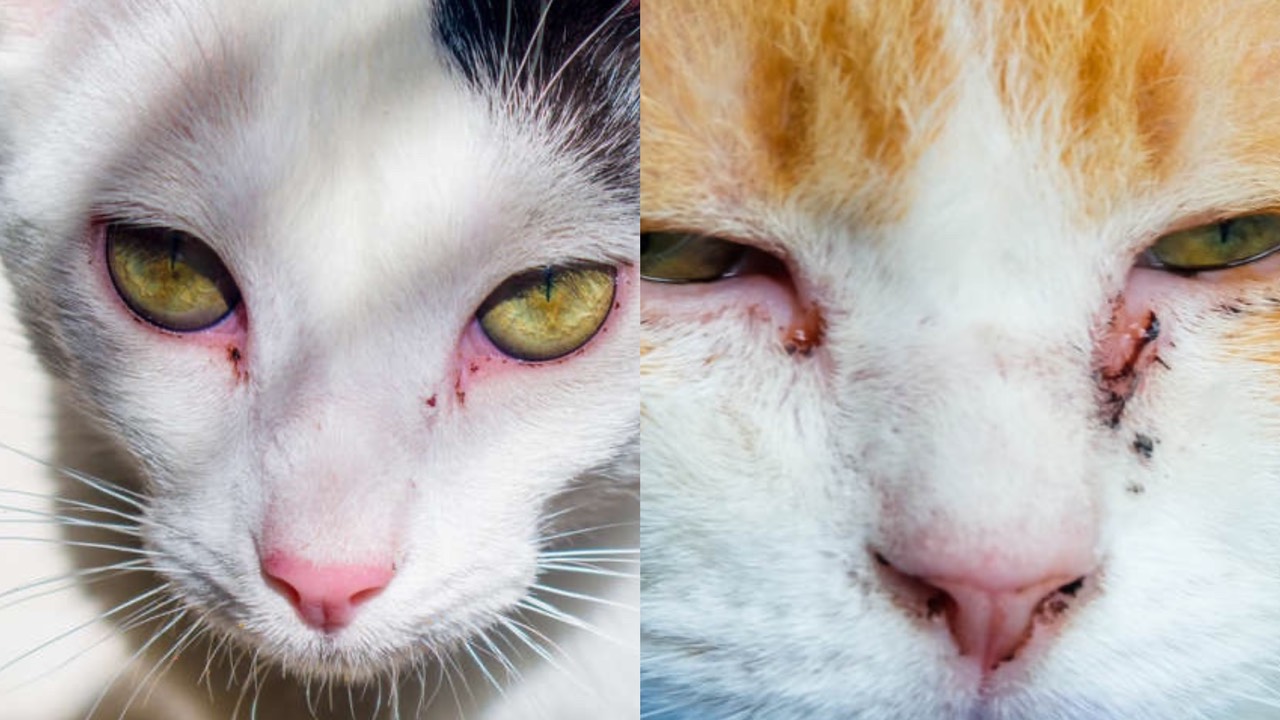
Cats can be susceptible to red discharge from their eyes and it’s important for the owners to be aware of this. As a Veterinary Ophthalmologist, I have treated many cats with red eyes and red eye discharge issues. In this article, I will give you an explanation of the different conditions that can lead to red ocular discharge in cats, as well as their corresponding symptoms. This will help you identify and address these conditions promptly and competently, preventing any permanent damage or loss of vision.
A change in color of the mucous thread to red, green or yellow is a reliable indicator of the presence of inflammatory cells and mandates a careful examination as ocular surface disease is also frequently present. (Slatter’s Fundamentals of Veterinary Ophthalmology; Fifth Edition; David J. Maggs; Paul E. Mille; Ron Ofri; Lacrimal System; Chapter 9; Page 167)
Symptoms to watch for if your cat has a red eye discharge
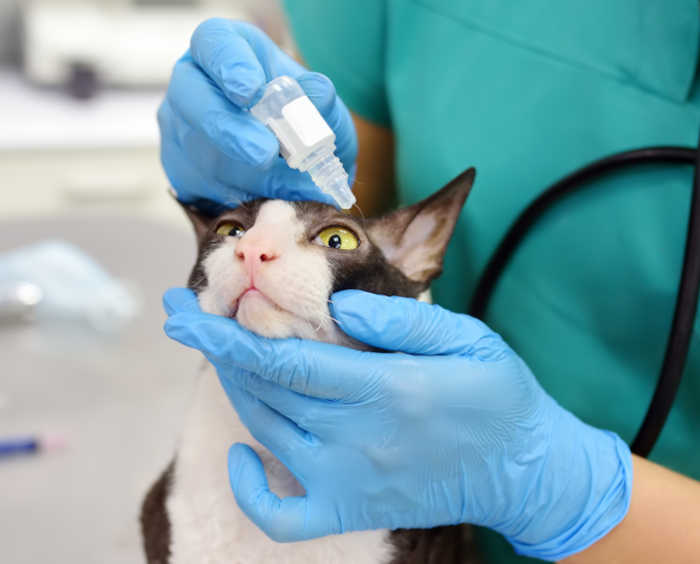
When your feline friend has an issue with their eyes, some signs you may observe include:
- Red ocular discharge or weeping
- Pain/blinking/keeping one or both eye(s) closed
- Third eyelid protruding
- Eye redness or swelling
- Eye cloudiness
- Coughing, sneezing, nasal discharge or any other symptoms
Most common causes of red ocular discharge in cats
Common causes include: conjunctivitis, allergies, eye ulcers, eyelid infections, tear staining in flat-faced cat breeds, blocked tear ducts and eye injuries, as outlined below.
1. Conjunctivitis
Conjunctivitis, the most common of all feline eye disorders, is an inflammation of the thin mucous membrane (conjunctiva) that lines the inner surface of a cat’s eyelids and coats the outer surface of the eyeball. Many cats will experience at least a mild episode of the condition at some point in their lives.
The clinical signs of the condition can be evident in either one or both eyes and will typically be observed as well in the third eyelid—the membrane positioned in the inner corner of a cat’s eye, between the lower eyelid and the eyeball.
The signs include:
- Pain/blinking/keeping one or both eye(s) closed.
- Presence of a discharge that, depending on the cause of the conjunctivitis, can be either colorless and watery or red colored.
- The conjunctiva and third eyelid become swollen and red.
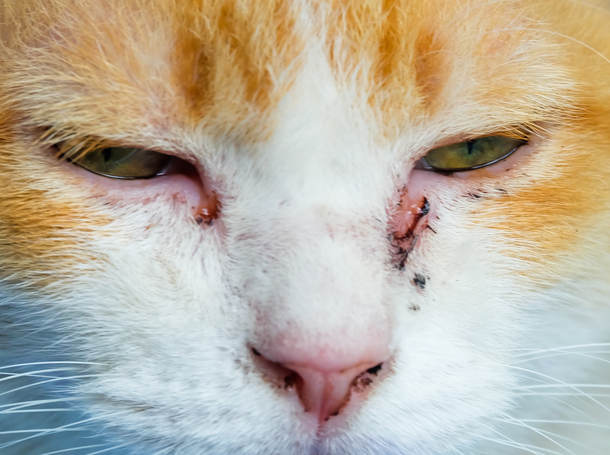
Treatment
Veterinary treatment is usually all that is needed to manage mild conjunctivitis as it should not last long. Speak to your vet to discuss the right action plan. If your vet suspects that there is an underlying condition causing your cat’s conjunctivitis, they may need to run more tests or examinations to determine the cause.
It is likely your vet will recommend the following treatments: – Anti-inflammatory treatment – Topical or/ and systemic antibiotic for bacterial infection – Topical or/ and systemic antiviral medication for viral infection
– Lubricating drops
2. Allergies
One of the most common medical conditions affecting cats is allergy. Allergy occurs when the cat’s immune system overreacts or is hypersensitive to foreign substances called allergens.
Allergy signs in cats include:
- Sneezing
- Ocular (eye) red discharge
- Sometimes nasal discharge (clear, brown, red, grey, or yellow)
- Coughing
- Wheezing
- Itching skin – in one part of the body or the whole body
- Vomiting
- Flatulence
- Diarrhea
There are four common types of allergies in cats: insect (fleas), food, atopic (house dust, pollen and mold) and contact. Learn more about cat allergies.
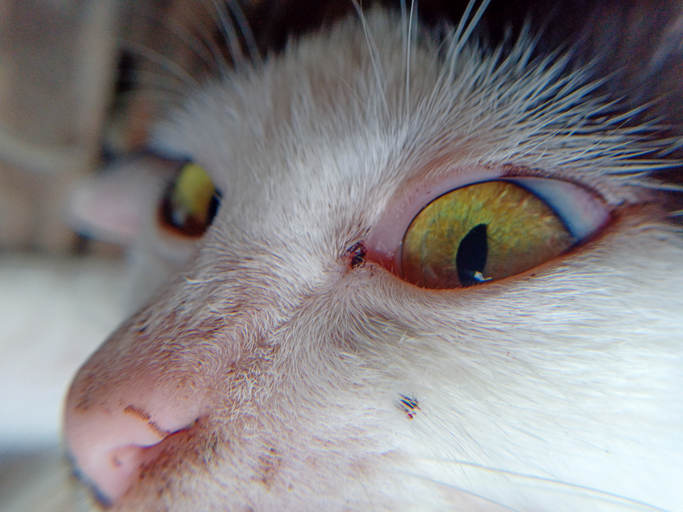
Treatment of cat allergies
If your cat shows signs of allergies, it might be necessary to manage the condition. There are three main ways to manage allergies in cats:
- Try to avoid the triggers;
- Treatment to manage itchy skin and watery eyes;
- Immunotherapy/vaccination treatment.
In case your furry friend is experiencing itchy skin, watery eyes, red discharge from their eyes or any other symptoms mentioned earlier, it’s crucial to seek help from your veterinarian. Itchy skin and watery eyes in cats usually don’t subside on their own and can lead to discomfort and misery for your pet, regardless of the underlying cause.
When a cat experiences anaphylaxis, it means that their body is having a severe and potentially life-threatening allergic reaction to something they have ingested or been exposed to. It is crucial to seek immediate medical attention for your cat if you suspect they are experiencing anaphylaxis. Common symptoms in a cat experiencing anaphylaxis include collapse, breathing difficulties, hives, facial swelling, itchiness, swelling, trembling, wheezing, and more. Learn more about anaphylaxis.
3. Eye ulcers
Corneal ulcers, which are injuries sustained to the cornea of the eye, must be treated in order to resolve. If left unattended, they can result in severe consequences such as blindness. Feline corneal ulcers have a wide variety of potential causes, including:
- Viral or bacterial infection. According to Thomas Kern, DVM, associate professor of ophthalmology at Cornell University’s College of Veterinary Medicine, the most frequent cause is recurrent infection with the feline herpesvirus (FHV).
- Cat scratches
- Ingrown eyelashes
- Foreign body
- Being exposed to caustic chemicals
The clinical signs of corneal ulceration include:
- Inflammation surrounding the cornea
- Ocular discharge (red, clear, brown, grey, or yellow discharge) or weeping
- Clouding of the cornea
- Photophobia
- Squinting, rubbing the eyes, behaving as if having vision problems
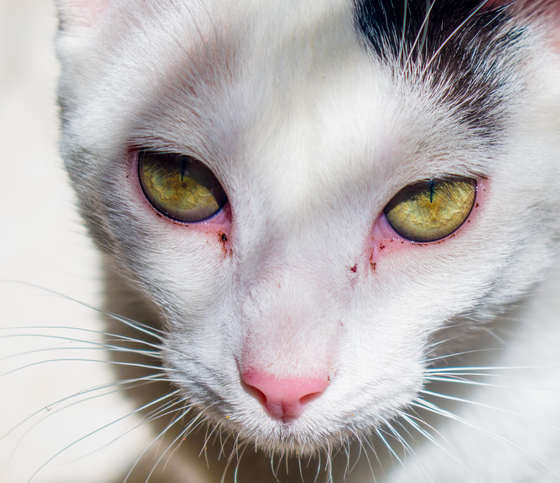
Cat with red ocular discharge
4. Eyelid infections
Blepharitis means inflammation of the eyelid. The clinical signs include:
- Scratching or rubbing its face or eyelids leading to secondary trauma to the surrounding tissues.
- Possible discharge from the eye that may be red, clear, brown, mucoid, or purulent.
- Inflammation has been present for a significant amount of time, there may also be loss of pigment or hair.
- Skin covering the eyelids may have dry crusts or flakes on its surface and small papules or pustules (pimples) may develop on the surface.
- One or more meibomian glands (glands that help lubricate the eyes) along the margin of the eyelid may become swollen.
- In more severe cases, the inflammation may spread and include conjunctivitis (inflammation of the conjunctiva) or keratitis (inflammation of the cornea).
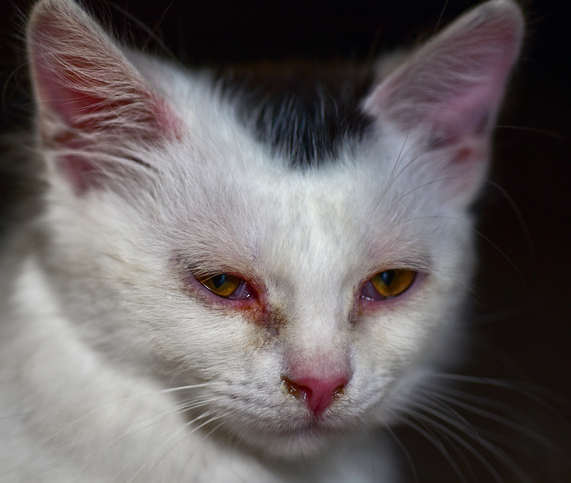
The cause of blepharitis include:
- Entropion.
- Allergies.
- Infections (bacteria, fungal, viral, parasites, or protozoal). Cats that have been infected with feline herpes virus-1 (FHV-1) may develop chronic blepharitis as a secondary problem. Bacterial infections may cause localized abscesses of glands in the eyelids or generalized infections of the eyelids. In some cases, infection with Staphylococcus bacteria (staph) may lead to an allergic reaction, called Staphylococcus hypersensitivity.
- Tumors.
- Trauma.
- Occasionally other inflammatory disorders.
Persian, Himalayan, and Burmese cats are more likely to develop blepharitis due to their facial conformation (flattened faces, and prominent folds of skin between the nose and eyes). These breeds of cats may have lagophthalmos (bulging eyes) and they are predisposed to lower eyelid entropion.
5. Tear staining in flat-faced breeds
Flat-faced breeds like Persians are more prone to tear-staining since they have large eyeballs in small eye sockets, which don’t allow the tears to drain away properly. This is a common issue for these types of cats, and needs to be addressed accordingly.
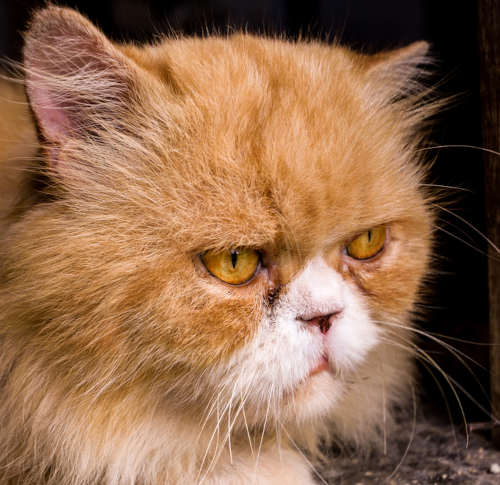
6. Blocked tear ducts – cause tears to spill down the face
The lacrimal duct is part of the nasolacrimal system. The nasolacrimal system consists of a series of narrow tubes that allow tears to drain from the eye. This system allows for the drainage of excess tears from the eye to the nose and mouth. Although it is less common in cats than in dogs, cats also have this nasolacrimal duct which can become blocked or obstructed. Such an obstruction can cause tears to overflow from the eye, leading to tear staining and excessive moisture below the eye.
Causes include:
- Shape and size of the cat’s head and muzzle.
- Hereditary defect in the formation of the nasolacrimal duct. This defect results in the lack of an opening where the nasolacrimal duct meets the conjunctiva (pink tissue surrounding the eye). This is referred to as imperforate puncta.
- Inflammation or infection, within the eye or lacrimal duct, may lead to swelling that blocks the duct.
- Tumors that develop along the duct.
- Foreign material lodged within the lacrimal duct.
Treatment of lacrimal duct obstruction
Many cases of nasolacrimal duct obstruction are caused by inflammation. In these cases, anti-inflammatory medications and antibiotics may alleviate the obstruction. In other cases, surgery may be required for treatment.
When to contact your vet
If you notice any issues with your cat’s eye, it’s crucial to act quickly and seek advice from a veterinarian. The vet will carefully examine the eye and suggest an appropriate treatment plan based on their evaluation. It’s important to address any problems promptly to ensure the well-being of your cat.

7. Eye injuries, ocular foreign body or trauma
If your furry friend is displaying signs like avoiding bright lights, keeping its eye closed or squinting, it’s likely that it has suffered an eye injury. It can be extremely severe and cause blindness if left untreated. So don’t wait and take your cat to the vet as soon as you noticed the symptoms for prompt diagnosis and proper treatment. If your cat has sustained an eye injury, the symptoms will usually appear quickly and worsen with time. It is important to look out for these tell-tale signs that could indicate an eye injury:
- Pain/blinking/keeping eye closed
- Red ocular discharge or weeping
- Third eyelid protruding
- Eye redness or swelling
- Eye cloudiness
- Blood in the eye
- A change in the size/shape of the pupil
Treatment:
The amount of treatment required for any sort of eye injury in cats depends on its severity and which part of the eye is affected.
Penetrating Injuries: If the injury has not perforated the eye, your vet may recommend anti-inflammatory and antibiotic medications or eye drops may also be prescribed to reduce eye inflammation. Antibiotic ointments are commonly used in the treatment of corneal ulcers.
Perforating Injuries: Surgery is the go-to option for any incident involving a perforation – such as a tear in the cornea, or when an object is embedded in the eye. Even full-thickness wounds can be treated this way. In case there is a foreign object, surgery may also be done to remove them from the eye.
When you should contact your vet about cat eye issues
If your cat is showing signs of discomfort in their eyes, such as excessive blinking or keeping one eye closed, not eating, being lethargic or hiding away, they may be in a lot of pain. It is important to contact your veterinarian immediately if you notice any of these symptoms. Some of these issues could be more serious than others, so it is best to seek professional advice. If left untreated, the problem could worsen. You know your cat better than anyone, so don’t hesitate to contact your vet if you are worried.
Learn more about cat eyes. and home remedies to help a cat with teary eyes.


